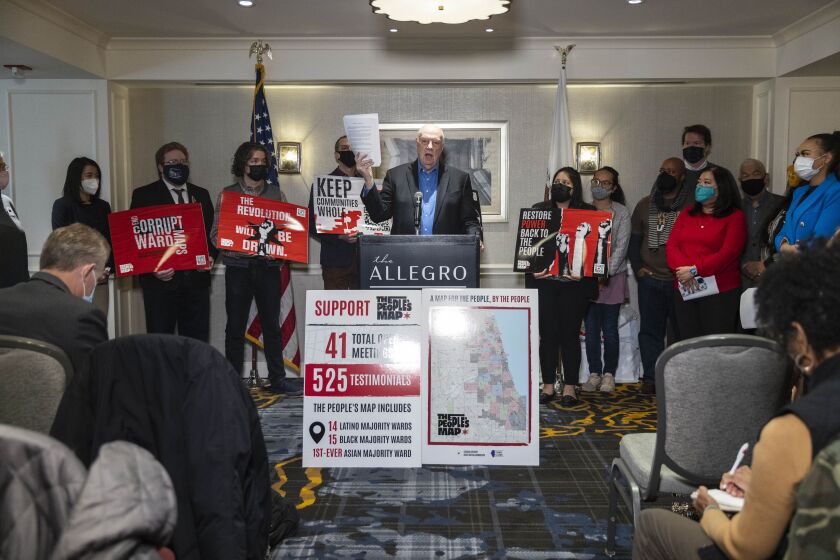Conceding to population shifts over the past three decades, the City Council’s Black Caucus on Monday unveiled a proposed ward map that gives up one majority Black ward and adds a Latino one.
Splitting the city into 17 majority Black wards and 14 majority Latino wards is “a good opportunity for all of Chicago,” Ald. Jason Ervin (28th), chairman of the Black Caucus, said.
But that’s still one ward shy of the 15 that Latino alderpersons contend their community deserves — making the Black Caucus proposal one that the City Council’s Latino Caucus said “disenfranchises” their community, packing them into wards and diminishing their ability to gain elected office.
“If this is something that the Black Caucus wants to use to start discussions, I can tell you that they’re off on the wrong foot,” said Ald. Gilbert Villegas (36th), head of the Council Latino Caucus.
With just nine days until the Dec. 1 deadline to submit a map, the City Council members and other stakeholders appear far from an agreement.
The proposal from the Black Caucus would make the 11th Ward — the historic home base of former Mayor Richard J. Daley and his family — an Asian-majority stronghold, Ervin said. The remaining 18 wards would be majority white.
“We believe this is a good opportunity for all of Chicago,” Ervin said at the Harold Washington Cultural Center, flanked by members of the Black Caucus. “I think that we have focused our efforts on being intentional about protecting our community but at the same time recognizing that other communities have made gains in the city and, again, this is where we are, and we believe that this is fair for all of Chicago.”
Census figures released in August show Chicago’s Black population dropped nearly 10% over the past decade to 801,195, while the city’s Latino community saw population gains of 5.2% over that same period for a total of 819,518, bypassing African Americans as the city’s largest minority.
Overall, Chicago’s Black community has decreased by 275,000 since the 1990 Census.
The proposal that members of the Black Caucus introduced on Monday didn’t set exact ward boundaries, but laid out a plan for mapmakers to follow. The draft was submitted to the City Council’s Rules Committee.
Under the Black Caucus’ plan, most of the 18 majority white wards would be on the North and Northwest Sides of the city — with one ward on the Southwest Side.
The proposal splits Latino Wards into areas on the Northwest side, West Side and far Southeast Side. Majority Black wards would remain on the West Side of the city as well as much of the South Side.
The proposed areas were created using voting age population figures.
Asked why they didn’t create 15 Latino majority wards, the Black Caucus’ cartographer Edward Sarpolus said the focus was on making sure that the various communities could win elections in the wards drawn for them.
A lot of voters in the Asian and Hispanic communities are under 18 “so the question is can they win that ward,” Sarpolus said.
“It’s kind of hard to go to a person saying ‘yeah, we drew you a ward, but you can’t win it,’” the caucus’ cartographer said.
Sarpolus said the same consideration was given for majority Black wards.
The Black Caucus’ proposal joins others created by the Latino Caucus, which was introduced last month, and another draft created by the independent Chicago Advisory Redistricting Commission, which was filed with the Chicago city clerk Monday.
Ervin said the Black Caucus supports its proposal, while there are currently 15 sponsors of the Latino Caucus’ map, Villegas said.
It takes 26 votes to pass a map, 34 votes to override a mayoral veto and 41 votes to avoid a referendum on the map.
Citing the rise in the Hispanic population, the Latino Caucus has said any map with fewer than 15 Latino-majority wards is “non-negotiable.”
Villegas said the proposal from African American City Council members was “concerning.”
“This is something that, if it were to actually come into ordinance format, come up and get voted on — and it passed and the mayor signed it — would be illegal and immediately trigger federal litigation,” he said.
He rejected the Black Caucus cartographer’s claims about drawing winnable wards.
“Our mapmaker was able to draw 15 wards and, quite frankly, we could’ve drawn 16, but we went with 15 because we wanted to make sure that these were opportunity wards that would allow for the opportunity to elect a representative from the community,” Villegas said, adding those wards are “defensible” and could sustain a legal challenge.
Ervin said the Latino map “attacked the African American community” and if his Latino colleagues are serious about electing people to represent those communities, then “we believe that 14 is the appropriate number for electability for those particular communities.”
At an unrelated news conference Monday, Lightfoot said the two sides “put their stakes in the ground” too early and now must reach a compromise.
“The fact of the matter is, if they don’t reach a compromise, most of the members of the City Council are going to lose — most of them will lose, some won’t, but most of them will,” Lightfoot said. “Because, if they throw this to referendum, anything is possible. ... They’ve got to recognize the art of compromise.”







